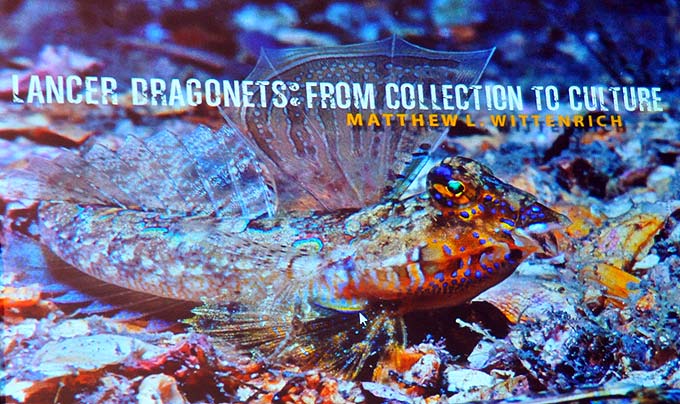MACNA attendees always get something special they may get nowhere else. This time around, Dr. Matthew L. Wittenrich (Dr. Witt for short) developed one of the most modern and progressive-minded presentations I’ve seen, and he did it exclusively for MACNA first. If you didn’t got to MACNA, you may well never get to see it!
Well, as if Dr. Witt hadn’t already claimed enough success with the Dragonets, he had to sneak yet another one by this contributor and take on the challenge of breeding Lancer Dragonet (Callionymus bairdi , and per Dr. Witt, now called Paradiplogrammus bairdi). The Lancer Dragonet is an extremely rare-in-the-trade fish from Florida and the Caribbean that I have only seen available once since I knew it even existed. Our beloved 2010 MACNA Aquarist of the Year, doing his best Britney Spears impression with the ear mic, took the stage on Saturday to share the video-based presentation documenting the project from its inception to current status.
Those who attended got an inside look at the process of locating, observing, collecting, spawning and attempting to rear what might best be called the Scooter Blenny of the Western Atlantic. With a complex social structure that includes dominant and sneaker males, wild observation gave stunning insights into how this fish might behave in captivity. The very concept of “saboteur” males is astonishing. These males will interject into the active courtship of the dominant male with a receptive female in an attempt to disrupt spawning. They will go so far as to actually depress the flared dorsal fin of the dominant male, ruining his display, and even go through the motions of mating with the male as if they themselves were female, only to then later go mate with the female that he had been courting prior.
Dr. Witt continued on, documenting how extremely small this species is from a reproductive standpoint; with eggs only at the 500 micro mark, newly hatched prolarvae under 1 mm in length, and 4 day old first feeders at only 1.09 to 1.10 mm in length, these fish represent some of the absolute smallest pelagically spawned marine fish being worked with by anyone to date. As of MACNA time, the larvae had been alive for over 40+ days and had yet to settle out as juveniles, further proving that not all Dragonets are equal (your typical Green and Spotted Mandarins would have settled weeks ago). And that’s where the story was on September 10th, 2011. Well…

Talk about twisting the knife Dr. Witt! Free and clear, this is a “species first” belonging to Dr. Matthew L. Wittenrich. There’s still hope for me to to claim my own Dragonet first with Synchiropus circularis, if I ever find it, unless the good doctor gets his fins on them first!
Matt describe this very exciting week in email. “A single Lancer Dragonet settled 49 days post hatching, then 3 settled at 51 dph, and 3 more around 53 days, which would be today. I have about 20 larvae in the water column that are showing signs of dropping out so things are fantastic. It is hard to get people excited about a 4.3 mm brown fish on the bottom of a tank, but for me, this is a huge accomplishment. They hatch under a mm and start feeding at just over. This, coupled with a 50 day larval cycle really assures me that the Lancer is a great model and confidence booster to target angelfish and other small egg species.” For those who go to hear Matt’s talk at MACNA, you may recall his mention of what a small-egg species represented..i.e. in this case a 0.5 mm egg that I believe he said “terrified” him.
Matt went on to mention that, “The pelagic larvae are bright orange and when they settle they hold this orange color for about 2 days before turning a mottled tan color”, which you can kindof still see in the photograph above. Dr. Witt also wanted to make sure that we recognized that he did not acheive this success alone, asking that we be sure to recognize Christine Creamer and Eric Cassiano for their valued contribution to larval rearing. Indeed, it seems that seldom is a successful venture into the unknown done alone – collaboration and open sharing seem to be the hallmark of how we move captive breeding forward in marine fishes.





